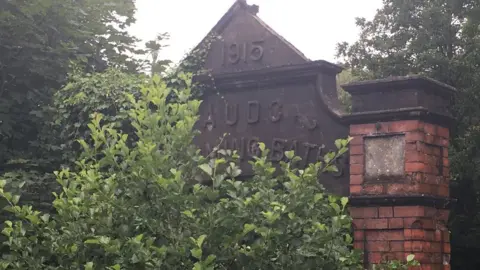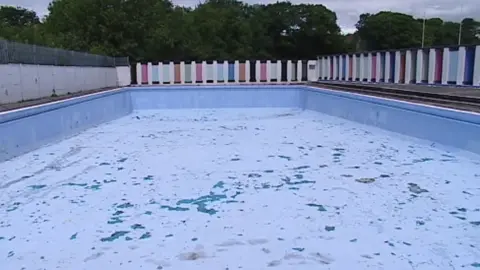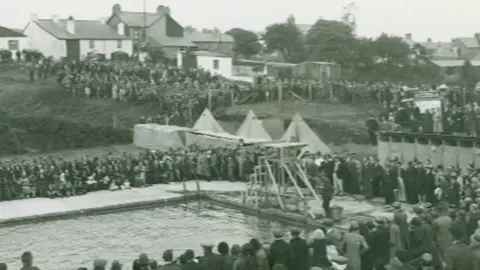Is building a lido in Wales swimming against the tide?
 LIDO PONTYPRIDD/CARDIFF LIBRARIES
LIDO PONTYPRIDD/CARDIFF LIBRARIESCampaigners in Abergavenny are the latest to try to bring back their much-loved outdoor pool.
But why did so many communities once have what is now a rare facility?
As far back as the 1850s, newspaper reports from Wrexham to the Rhondda tell of campaigns for outdoor swimming baths.
Cardiff's Guildford Crescent is believed to be the site of the first of 50 open air pools in Wales.
A roof was later built over it before it was bought by the local authority - and known as the "Corporation Baths".
Historian Dr Daryl Leeworthy from Swansea University said it was not the most hygienic of experiences in the early days.
"When it opened around 1862… It was situated alongside the railway line," he said.
"So every day the locomotives would come along, burning coal and the soot would sit on the baths.
"A first class ticket holder would go in when the water was fresh and you'd have a brilliantly clean bath.
"But the water wasn't changed for the other ticket holders.
"If you were the third class ticket holder, you'd be swimming not just in the dirt of your peers but also everyone else who'd gone in all week and the soot that came off the train."
It took some communities decades of lobbying to get similar facilities, with the 1920s and 30s arguably the boom years for their construction, amid tensions in the coal industry.
"The government tries to ameliorate those tensions by coming up with the Miners' Welfare Fund - designed to provide education, healthcare and recreational facilities in coalfield areas which they hoped would make coalfield communities less riotous," Dr Leeworthy added.
"It provided a levy of a penny per tonne of coal pulled out of the ground, so it was essentially a business tax, if you like, and that money was directed to local committees who responded to grant applications from communities.
"So the swimming pools and recreation grounds that were built were very much a demand from communities themselves."

The depression in the 1930s meant funding for pools came from another source - the "Special Areas Commission", which allowed councils to employ local people purely to build local amenities.
Around 12 pools were either upgraded, such as the Lido in Pontypridd, or built for the first time.
During the 1970s and 80s many pools were in disrepair and some newly formed county councils converted open air baths into indoor facilities, such as Splott Pool in Cardiff.
But others such as Pontnewynydd Baths near Pontypool were filled in and turned into parks.
Lisa Barrett spent most of her childhood summers at Bailey Park Pool in Abergavenny, Monmouthshire, where her mother ran the facility.
 Forgotten Abergavenny/Crown Copyright/UGO SCHULTZ
Forgotten Abergavenny/Crown Copyright/UGO SCHULTZ The local council says it would now be difficult to find a business model that works for an outdoor pool.
But Ms Barrett said hundreds of local people are behind the idea of digging deep and resurrecting it.
"We understand where they're coming from with regards to money," she said.
"But we've had a lot of builders and tradesmen come to us and say we'll help and make this a reality."
 TBC
TBCCampaigners in Brynamman, Carmarthenshire, like Jason Rees, say they're looking at new designs which could reduce operating costs, but they need all the help they can get.
"We're looking at ways of keeping it open for longer," he said.
"Not just the summer months and we're looking at cleaning it without chemicals - a naturally cleaning pool... at no cost other than the up front cost of building it.
"I'd like to see a few more local people involved to generate income or volunteer their time to help us with it."
 International Voluntary Service
International Voluntary ServicePerhaps history could repeat itself as in 1931 when the International Voluntary Service turned up in depression-hit Brynmawr in Blaenau Gwent where unemployment was 80% or more.
Dr Leeworthy said: "They came across to south Wales with all these volunteers from Poland, Belgium some of them even from the United States, France, Norway and so on, to help miners in Brynmawr to build this swimming pool.
"It's a remarkable transformation of an area, providing a leisure facility which had long been wanted but had been found difficult to provide.
"The local authority simply had no money, it's having to deal with massive levels of unemployment and that's its primary focus."

The Lido in Pontypridd was reopened in 2015 after decades of planning and millions in charitable grants.
Dr Leeworthy catalogued more than 50 outdoor baths across Wales as part of his research into the recreation facilities - he says there is a lesson to be learned from the only outdoor pool still open in Wales.
"There's a lesson of patience… the future in the long term of sites like this is really that against times of hardship people focus on things that can transform their communities for the longer term," he said.
